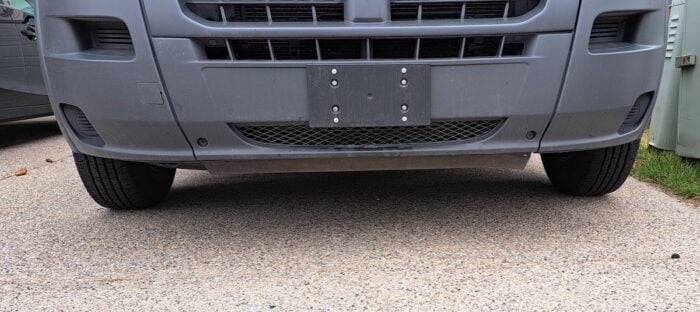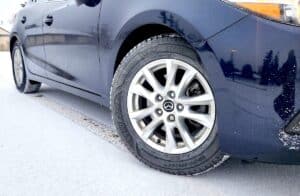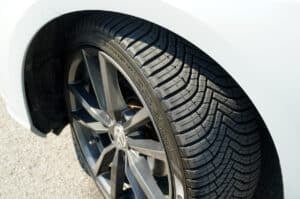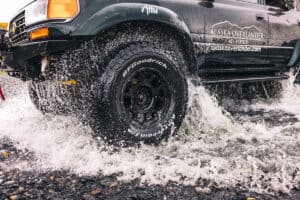Quick Specs:
- Tire Type: All-Season
- Season: Three seasons (designed for on-road performance)
- Sizes: 70 sizes from 14 to 20 inches in diameter
- Tread Pattern: Fine tread pattern reduces roll resistance and hydroplaning
- Tread Depth: 12.5-15 mm, depending on tire size
- Speed Rating: S (180 km/h or 112 mph), T (190 km/h or 118 mph), or H (210 km/h or 130 mph), depending on tire size
- Load Index: E in the LT version, C and D for some car sizes
- Warranty: Standard 115,000-km (70,000-mile) warranty, plus Pothole Protection
Alternative brands: Michelin Cross Climate 2, Goodyear Assurance, Continental All Season Contact, Hankook Ventus S1 EVO3

On a recent visit to replace a tire destroyed by road debris, a tire shop in town offered me a brand I had never heard of. “Where is it made?” I asked. “China.”
I didn’t buy that tire, even though the price was roughly half of the big brands on the market. Scrolling through online reviews later, I read horror tales of sidewall failure and other premature safety issues with the brand.
The point is that thoughtlessly grabbing what seems like a bargain can have consequences. If a cheap toaster breaks down, you throw it away and buy another one. A tire failure, on the other hand, could have much more serious consequences. If ever there was a time to stick with brands that have hard-earned reputations for quality and safety, it is now.
These no-nonsense tires were unremarkable in appearance and with little to attract attention to them. There may be times that showy tires are a virtue, but mounted on the ProMaster is not one of them.
Which brings us to Nokian, the Finnish tire maker that manufactures most of its products for the North American market at its factory in Dayton, Tennessee. The company, founded in 1988 but with roots that go back to the Finnish Rubber Works in 1898, is known for innovative products, environmental sustainability and – most important of all – safety.
Having had a positive experience with the Nokian Outpost nAT all-weather tires, I had high expectations of the One HT all-seasons, even if they are not as sexy-looking as the nATs. These are working tires, ideal for small business vans or SUV owners who don’t plan to spend much time off-road. As all-season tires, they are meant to be driven in temperatures of 7 C (45F) and warmer—not on snow and ice.

Their rubber compounds and tread patterns put the accent on performance and durability on spring and summer roads, but they are not ideal for use in snow and ice. (It should be noted they have “grip blocks” between the tread blocks to improve grip on mud, snow, and ice.) Like all all-seasons, their rubber compounds harden up in bone-chilling cold.
Naturally, several quality brands are available to shoppers looking for great spring/summer tires. The One HT should be on the shopper’s list. It comes with a reinforced construction designed for protection against road and trail hazards and a solid warranty that includes protection against pothole damage.
The One HTs were fitted on a RAM ProMaster 1500 van, where they assumed a competent but modest profile. These no-nonsense tires were unremarkable in appearance and with little to attract attention to them. There may be times that showy tires are a virtue, but mounted on the ProMaster is not one of them.
Tire Grip And Traction

Most of the testing of these tires was on pavement, with occasional forays into gravel and soft soil. These tires are not meant to paw out of muck, so it’s best not to go there with them. But on pavement, they are sure-footed and hold well, especially when cornering as aggressively as you dare in a tall van.
Zipping along long paved roads is as peaceful as a trip to the spa, with the vehicle sitting stable and feeling absolutely sure-footed. The net effect is a drive that lets you settle into a relaxed groove to the soulful music of a group like Khruangbin.
Quiet, stable but not jarring, and with plenty of stickiness in both dry and wet conditions, they are great all-round three-season tires.
The pothole warranty applies to Nokian tires that have Aramid fibres in the sidewalls and beneath the treads, like the One HT. This miracle fibre, the company notes, is the same material used in bulletproof vests, and it reinforces the sidewall to resist both wear and cuts. In the unlikely event a tire is damaged beyond repair by a road hazard, Nokian will replace it at no cost.
This is especially valuable on evil, tire-eating roads like those we encountered this spring in Baja. For those who haven’t had the pleasure, Baja roads have sections where potholes pile upon potholes, with sharp-edged rocks poking through just for fun. In remote areas of the Mexican state, ramshackle shops selling used tires await unfortunate travellers who have no choice but to stop.
Thankfully for us, our Nokians faithfully rolled on by those shops.
Tire Noise And Comfort Levels

Vans are noisy by definition, but thankfully none of that racket came from our One HTs. Tread noise was minimal and yet – despite those Aramid-reinforced sidewalls – the ride was compliant and not jarring in the least. They were clearly an improvement over the factory rubber they replaced, in both noise level and comfort.
Consumer Reports tested the tires and found that the One HT has very low rolling resistance because of the rubber compound and fine tread design. I found the engine just seemed to be less laboured as the van ambled along two-lane highways. That easy cruising means you can expect better-than-average fuel economy. They roll so nicely, Nokian claims they are well-suited to EVs.
Related – Review: Nokian Outpost AT All-Terrain Tires
That same CR report noted One HTs are also excellent at resisting hydroplaning, cutting through the wet to stay glued to the road. The tires remained composed even when pressing hard through corners, accelerating aggressively or panic braking. It took a lot of effort (and a little leftover winter gravel) to get them to break traction.
Mounting And Balancing the Nokian One HT Tires

One of the underappreciated pleasures of premium tires is that they are actually round – truly round. A lot of tires, including those bargain ones, are ever-so-slightly off-kilter, which drives tire installers to add a little Irish Cream to their Tim’s coffee as they struggle to get them right. Balancing these tires required very little adjustment, my installer told me.
Takeaway: Is The Nokian One HT Worth Buying?
If you’re planning on driving your vehicle for at least another 100,000 K or 70,000 miles (Nokian claims you can expect them to last for 130,000 kilometres, or 80,000 miles) and if you want peace of mind at both highway speeds and while slamming over washboard gravel, then the One HT will do the job for you nicely.
They are unquestionably better than most factory equipment tires, are priced competitively with other major brands, have a great warranty and are built to go the distance with next-to-no attention. Quiet, stable but not jarring, and with plenty of stickiness in both dry and wet conditions, they are great all-round three-season tires. Keep in mind, if you live where the roads freeze, you’ll need to swap them out in winter.
If you’re shopping for all-season tires, make sure to read our guide – 16 Best All-Season Tires: SUV, Cars & High-Performance.






